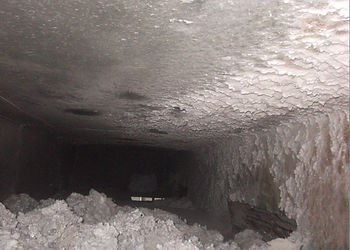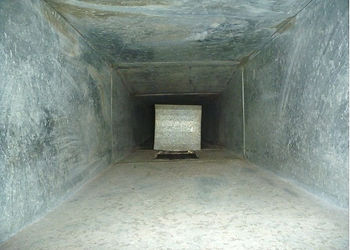
Just because you can’t see it or smell it does not mean your HVAC system isn’t posing a potential danger to your health !!!
According to reports by well known health care organizations indoor air quality is a paramount environmental health care concern. The indoor air we breathe is up to 70% more polluted than outdoor air hence Indoor Air Quality is a major concern because we spend majority of our time indoor, roughly about 90%.
Considering the biological fact that adults inhale 23,000 times a day (Children breathe almost twice as fast as adults),Each day we breathe 32 pounds of oxygen plus whatever is in the air, the average 5000 Sq. ft office collects 120 pounds of dust a year, which means an average person breathes in 4 teaspoons of pollutants at home & work per day.
Indoor air pollution is bigger killer than outdoor air pollution in India with the recent global burden of diseases report listing the former as second biggest killer and later as fifth largest. Around 1.3 million people died of indoor air pollution in 2010 whereas death because of outdoor air pollution was around 6.20 lakhs. Indoor air pollution is second biggest killer after high blood pressure in India . About 1/6 people who suffer from allergies do so because of the direct relationship of the fungi and bacteria in the air duct systems
A build up of 0.42 of an inch of dust on HVAC can result in a 21% decrease in efficiency and around 9/10 heating, ventilating, air conditioning system failure are caused by dust and dirt. Dirty ventilation systems and contaminated ductwork combined is a 50.9% contributor to sick building syndrome.
80% of dust is made up of dead skin cells from people, we lose about 10,000 dead skin cells an hour, and we lose our outer layer of skin every 29 days, all this enters into the duct settles there and then the circulating air is gradually polluted.


AFTER
What is Duct Cleaning?
Duct cleaning generally refers to the cleaning of various heating and cooling system components of forced air systems, including the supply and return air ducts and registers, grilles and diffusers, heat exchangers heating and cooling coils, condensate drain pans (drip pans), fan motor and fan housing, and the air handling unit housing. If not properly installed, maintained, and operated, these components may become contaminated with particles of dust, pollen or other debris. If moisture is present, the potential for microbiological growth (e.g., mold) is increased and spores from such growth may be released into the living space. Some of these contaminants may cause allergic reactions or other symptoms in people if they are exposed to them.
Duct cleaning is an integral part of solving indoor air quality problems. “Source removal” technique for cleaning ducts is one among those globally endorsed by various organizations. These techniques utilize special vacuum equipment, brushes, and compressed air to agitate the dirt in the ducts. Properly cleaning air ducts is not a quick job. It usually takes between 6 - 8 hours for an office space of 12000-15000 sq. ft approximately. The duct cleaner should use equipment recognized by the National Air Duct Cleaners Association (NADCA). This equipment portable negative air power vacuum equipped with HEPA filters. A reputable professional will use the correct equipment, take the required time to do the job right, not damage your system during the cleaning process, and clean both the ducts and air conditioner components.
Benefits of Air Duct Cleaning
-
Less Internal Dust.
-
Improves Indoor Air Quality.
-
Improves efficiency of the cooling/heating system.
-
Saves money on Maintenance & Electricity Bills
-
Reduced allergy symptoms
Air Condition Duct Cleaning
BEFORE


BEFORE

AFTER
Kitchen Exhaust Duct Cleaning
Is Your Kitchen Exhaust System FIRE proof ??
Grease, a product of accumulation of cooking oil in ducts over a period of time, is highly combustible in any form, as per a reports every year 11,200 structure fires are reported by eating and drinking establishments. 80% of these fires originate in the cooking area, which can then explode into the exhaust system. Keeping a grease-free and fire-safe kitchen exhaust system can protect restaurants from fire damage. Regularly maintaining the kitchen exhaust system will ensure a safe & hygiene environment for cooking. A system that is safely working at peak performance will ultimately lead to a working environment that's cleaner, cooler and more productive for the staff.
What is Kitchen Exhaust cleaning all about?
Kitchen exhaust cleaning (often referred to as "hood cleaning") is the process of removing grease that has formed on the walls of ducts, hoods, fans and vents in restaurant kitchen exhaust systems. AcmeDuct offers specialized services for restaurant kitchen grease exhaust hood systems. We are dedicated to our trade, and offer the most knowledgeable and well trained kitchen exhaust grease hood cleaners and service repair technicians.
Benefits of Kitchen Exhaust Cleaning
-
Reduced risk of kitchen fires
-
Enhanced working environment for kitchen staff
-
Improved ventilation for smoke and odor removal
Frequency of Kitchen duct Cleaning
-
Kitchen exhaust systems generally require cleaning monthly to annually depending on many factors.
-
The greatest factor governing required cleaning frequency is the volume of cooking and severity of the cooking operation. Configuration of the exhaust system may also dictate increased frequency.
-
The cleaning frequency of the exhaust system should be specified to keep the system free of fuel load sufficient to support fire and operating at maximum efficiency.
-
Regular cleaning of grease filters greatly reduce system loading and remain recommended.
Kitchen duct cleaning approaches.
Several processes are used to clean kitchen exhaust systems. The most common is the use of chemicals to break down the grease, and hot water to rinse away the residue. Chemicals are generally applied with either a garden type sprayer, downstream injection through a pressure washer or with a chemical. Once the chemicals are applied, they are allowed to dwell on the surface of the grease for a period of time, before being washed off of the surface with hot water. In extreme situations, where grease buildup is too heavy for a chemical application and a rinse, scrapers may be used to remove excess buildup from the contaminated surfaces, before chemicals are applied.
In a nutshell, cleaning methods shall include but not be limited to the following processes or a combination thereof.
-
Removal of solidified; semi solidified or liquid cooking byproducts.
-
Low pressure application or facility approved detergents.
-
Wash/rinse processes utilizing high pressure or hot water cleaning.
-
Wash/rinse processes utilizing saturated steam cleaning.
At the close of cleaning operations exhaust blowers shall be restarted, all access doors utilized during cleaning shall be replaced and fastened, dampers positioned for proper exhaust airflow and electrical switches and system components returned to operable state.

Laundry Exhaust Duct Cleaning
How hot is your Laundry ? / feel like working in a furnace ?
Every commercial laundry has a duct or series of ducts – the exhaust system – that remove the hot, moisture-laden air from dryers and exhaust it outdoors on the roof or via an outside wall. This hot air is filled with lint particles that, over time, deposit inside the duct. Lint can stack up until it is inches thick. Regular maintenance is needed to remove the accumulation. Maintenance is commonly done every three to six months but may be needed as often as monthly. When maintenance is ignored, the lint buildup – which can eventually occupy 50-75% of the duct – can cause a lot of problems
The common signs that a laundry exhaust needs cleaning include:
-
Clothes taking too long to dry.
-
Excess lint buildup in the ducts, causing a fire hazard.
-
Dryer units automatically turning off because the heat is not exhausting.
-
Fire dampers in the ducts may malfunction.
-
Higher concentrations of lint in the indoor air.
-
Rusting of the ducts from holding wet lint for long periods.
Of all these things, fire is by far the number one concern. The lint buildup not only creates a fire hazard, but it inhibits fusible (low melting point) links on the fire dampers inside the duct that are supposed to close during a fire to prevent the flames from spreading. If the links are coated with lint, they may not be able to melt at the proper temperature so the fire damper may not close. Air quality is another issue, you get excess lint into the air because the exhaust can’t take it out and the lint gets into the heating and air conditioning system. Lastly, if you’re not getting the right flow through your vents, the back pressure can trip a relay switch and shut your dryer off. For hotels and similar establishments, customer service can be directly affected by the lack of laundry exhaust cleaning. Slowed drying times means towels and sheets not getting to the rooms on time, particularly when the house is full.

BEFORE

AFTER
Cleaning laundry ducts requires openings in the ducts so that lint can be removed (sometimes by crawling through the ducts). Even though building codes require that most laundry ducts be initially installed with such “access doors,” occasionally one or a few may need to be added so a thorough cleaning can be done. (We have found that those who install the ducts do not necessarily know how much access is required for proper cleaning.)
In essence, there are plenty of good reasons for maintaining the exhaust systems in a commercial laundry setting. A regular cleaning schedule is part of any recipe for a smooth-running operation.


BEFORE

AFTER
Fresh Air Duct Cleaning
How Fresh is the Fresh Air ?
In any commercial building fresh air intake is necessary for the occupants inside the facility. Normally 10 – 15 cycles of air change per hour is mandatory for a healthy breathing. When fans intake fresh air from the outer environment they also bring in pollutants like dust and bacteria which settle inside the duct and form mold growth. Over a period of time these ducts are filled with nuisance dust and pollens which pollute the indoor air quality.
The most effective way to clean air ducts and ventilation systems is to employ source removal methods of cleaning. AcmeDuctdoes this by placing the duct system under negative pressure, using one of our high powered HEPA filtered vacuuming systems. While the vacuum draws air through the duct system, air whips, rotary brushes and other cleaning devices powered by an air compressor are inserted into the air ducts to dislodge any debris that might be stuck to the interior surfaces. The debris can then travel down the ducts to the vacuum, removing it from the system. We have a highly trained team of NADCA certified technicians who can clean your HVAC system. We have experience in cleaning shopping malls, medical facilities, government buildings, hotels/restaurants, big/small kitchen/cafeterias, stores and high-rise buildings. Our robotic cleaning system allows our technicians to access even the most difficult locations to perform a professional air duct cleaning.
According to NADCA's energy savings research project, cleaning even lightly-fouled heating and cooling systems can result in energy savings of 11 percent. In addition to these savings, consumers who have their HVAC systems cleaned can benefit from improved indoor air quality, reduced maintenance costs and extended life expectancy for the heating and cooling system.
Fresh Air Duct Cleaning helps you:
-
Relieve allergy / asthmatic Symptoms
-
Removes contagious airborne allergens
-
Extract construction/remodeling dust, dirt, drywall dust, hair particles/pert dander, pollen, bacteria & mold.
